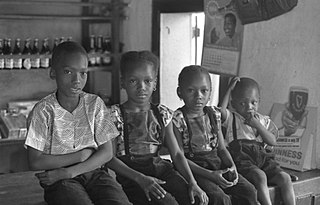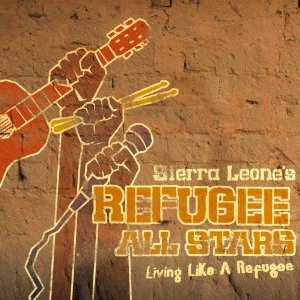Related Research Articles

Sierra Leone, officially the Republic of Sierra Leone, is a country on the southwest coast of West Africa. It is bordered to the southeast by Liberia and by Guinea to the north. Its land area is 71,740 km2 (27,699 sq mi). It has a tropical climate and environments ranging from savannas to rainforests. As of the 2023 census, Sierra Leone has a population of 8,908,040. Freetown is both its capital and its largest city. The country is divided into five administrative regions, which are further subdivided into 16 districts.
The music of Martinique has a heritage which is intertwined with that of its sister island, Guadeloupe. Despite their small size, the islands have created a large popular music industry, which gained in international renown after the success of zouk music in the later 20th century. Zouk's popularity was particularly intense in France, where the genre became an important symbol of identity for Martinique and Guadeloupe. Zouk's origins are in the folk music of Martinique and Guadeloupe, especially Martinican chouval bwa, and Guadeloupan gwo ka. There's also notable influence of the pan-Caribbean calypso tradition and Haitian kompa.

Sierra Leone's music is a mixture of native, French, British, West Indian and Creole musical genres.
The music of the Lesser Antilles encompasses the music of this chain of small islands making up the eastern and southern portion of the West Indies. Lesser Antillean music is part of the broader category of Caribbean music; much of the folk and popular music is also a part of the Afro-American musical complex, being a mixture of African, European and indigenous American elements. The Lesser Antilles' musical cultures are largely based on the music of African slaves brought by European traders and colonizers. The African musical elements are a hybrid of instruments and styles from numerous West African tribes, while the European slaveholders added their own musics into the mix, as did immigrants from India. In many ways, the Lesser Antilles can be musically divided based on which nation colonized them.
The music of Guinea-Bissau is most widely associated with the polyrhythmic genre of gumbe, the country's primary musical export. Tina and tinga are other popular genres.

The Sierra Leonean Creole or Krio is an English-based creole language that is the lingua franca and de facto national language spoken throughout the West African nation of Sierra Leone. Krio is spoken by 96 percent of the country's population, and it unites the different ethnic groups in the country, especially in their trade and social interaction with each other. Krio is the primary language of communication among Sierra Leoneans at home and abroad, and has also heavily influenced Sierra Leonean English. The language is native to the Sierra Leone Creole people, or Krios, a community of about 104,311 descendants of freed slaves from the West Indies, Canada, United States and the British Empire, and is spoken as a second language by millions of other Sierra Leoneans belonging to the country's indigenous tribes. Krio, along with English, is the official language of Sierra Leone.

The Temne, also called Atemne, Témené, Temné, Téminè, Temeni, Thaimne, Themne, Thimni, Timené, Timné, Timmani, or Timni, are a West African ethnic group. They are predominantly found in the Northern Province of Sierra Leone. Some Temne are also found in Guinea. The Temne constitute the largest ethnic group in Sierra Leone, at 35.5% of the total population, which is slightly bigger than the Mende people at 31.2%. They speak Temne, which belongs to the Mel branch of the Niger–Congo languages.
Music of the African diaspora is a sound created, produced, or inspired by Black people, including African music traditions and African popular music as well as the music genres of the African diaspora, including some Caribbean music, Latin music, Brazilian music and African-American music.
Jamaican Maroons descend from Africans who freed themselves from slavery in the Colony of Jamaica and established communities of free black people in the island's mountainous interior, primarily in the eastern parishes. Africans who were enslaved during Spanish rule over Jamaica (1493–1655) may have been the first to develop such refugee communities.
Jamaican Maroon language, Maroon Spirit language, Kromanti, Jamaican Maroon Creole or Deep patwa is a ritual language and formerly mother tongue of Jamaican Maroons. It is an English-based creole with a strong Akan component, specifically from the Fante dialect of the Central Region of Ghana. It is distinct from usual Jamaican Creole, being similar to the creoles of Sierra Leone (Krio) and Suriname such as Sranan and Ndyuka. It is also more purely Akan than regular Patois, with little to no contribution from other African languages. Today, the Maroon Spirit language is used by Jamaican Maroons. Another distinct ritual language consisting mostly of words and phrases from Akan languages, is also used by Jamaican Maroons in certain rituals including some involving possession by ancestral spirits during Kromanti ceremonies or when addressing those who are possessed and sometimes used as a kind of code.

Sierra Leone's Refugee All Stars is a band from Sierra Leone which was formed by a group of refugees displaced to Guinea during the Sierra Leone Civil War. Since their return to Freetown in 2004, the band has toured extensively to raise awareness for humanitarian causes. Their story is documented in the 2005 documentary film Sierra Leone's Refugee All Stars.
Maroon Town, Sierra Leone, is a district in the settlement of Freetown, a colony founded in West Africa by Great Britain.
The Jamaican Maroons in Sierra Leone were a group of just under 600 Jamaican Maroons from Cudjoe's Town, the largest of the five Jamaican maroon towns who were deported by the British authorities in Jamaica following the Second Maroon War in 1796, first to Nova Scotia. Four years later in 1800, they were transported to Sierra Leone.
Joseph Gerald Adolphus Cole better known by his stage name Daddy Saj is a Sierra Leonean rapper and arguably the biggest and most famous musician from Sierra Leone. He uses his music to address political corruption and general corruption in Sierra Leone. His rap is a blend of hip hop and traditional goombay music. While his music is mostly in Krio, Sierra Leone's national language, he does also performs in English. His first album 'Corruption e do so' struck a chord not only in Sierra Leone, but across Africa.
The gumbe or bench drum is a frame drum found in French Guiana, Jamaica and Sierra Leone. It has a small size, with square frame and one head of goat skin.

Living Like a Refugee is the debut album from Sierra Leonian band Sierra Leone's Refugee All Stars, released in the Europe on 25 September 2006 and in the United States on 26 September 2006.

Sierra Leone is home to around sixteen ethnic groups, each with its own language. In Sierra Leone, membership of an ethnic group often overlaps with a shared religious identity. According to the 2004 census Temne is the largest ethnic group in Sierra Leone.

The Sierra Leone Creole people are an ethnic group of Sierra Leone. The Sierra Leone Creole people are descendants of freed African-American, Afro-Caribbean, and Liberated African slaves who settled in the Western Area of Sierra Leone between 1787 and about 1885. The colony was established by the British, supported by abolitionists, under the Sierra Leone Company as a place for freedmen. The settlers called their new settlement Freetown. Today, the Sierra Leone Creoles are 1.2 percent of the population of Sierra Leone.
Ebenezer Calendar (1912–1985), or Ebenezer Calender, was a Sierra Leone Creole palm-wine musician who popularized Creole gumbe and palm-wine music in Sierra Leone and West Africa. Calendar heavily influenced Dr Oloh and other Sierra Leonean musicians. Ebenezer Calendar formed the music group, Ebenezer Calendar & His Maringa Band which was popular between the early to middle twentieth centuries.
References
- ↑ See the Bahamas Goombay 1951-1959 album (scroll down to read booklet in both French and English:)